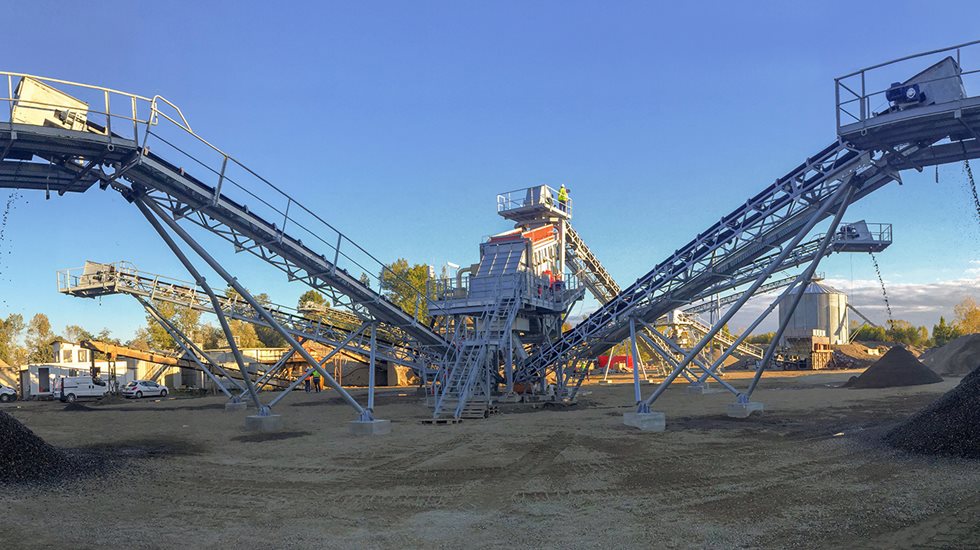Accurately identifying the plant’s needs requires us to visit the site and conduct a thorough appraisal of its operations, performance, history, raw materials, and current product, as well as how it can be adapted for the new one. If an issue goes undetected, for instance that their flow sheet is outdated or their equipment is worn, they may suffer major issues later on after the new solution is implemented.
Below I’ve outlined the five key steps to implementing a new production line from a Metso perspective.
Step 1: Current state analysis of the crushing process
The audit is key to helping us find a holistic solution that integrates with the site’s existing infrastructure. Considerations include balancing initial costs with future productivity, minimizing downtime, and not interfering with existing processes. Our solutions must also be flexible enough to deal with potential future parameter changes – identifying these is another challenge of the auditing process.
To minimize the risk of unpleasant surprises, we look deep into the plant’s operations, investigating the potential impacts of our proposed changes on overall performance and whether structural adaptations are needed to support them. We speak with everyone involved in the production process, as well as conducting lab tests and considering the site’s topography and material flow, alongside many other factors.
Step 2: New design for the aggregate plant
The new design is based on the audit results – although we’re creating an entirely new layout and process, we must still respect the current ones. When upgrading an existing operation there is much more to consider than if we were building an entirely new plant from scratch – for instance, the proposed adaptations may also require debottlenecking.
Step 3: Securing existing crushing operations for implementation
This step requires us to consider the business implications of any changes. A negative impact on existing operations is far from ideal, but the plant may need to adapt in order to compete – so we must take care to deliver a positive overall impact. We always keep the end goal in mind; do we need to overhaul the plant’s operations entirely, or can we minimize interference with a new side production line? To achieve balance, we may need to observe the plant’s operation for as long as a year before developing a modification schedule to find the best solution. However long it might take, we work closely with the client for the entire duration of the process.
Step 4: Implementation of the new aggregate production line
When installing a new production line every step has to be taken at the right time and in the right way. However thorough, our audits can’t uncover every possible variable, and we can experience unexpected issues – with the existing foundation or machinery, for example – so we must be flexible. Time of year may also be a factor, because we might be working with equipment that cannot be exposed to temperature extremes.
Step 5: Start up of the new aggregate plant
Once the new equipment and processes are in place, the plant’s operatives need to be trained; correct operations must be maintained because this is essentially a new plant, with new equipment, new procedures, and a new end product. Again, detailed analysis early on is key here: if we have performed a suitable simulation of the new process, the start-up will be quicker and smoother because the reality will match our predictions.
The main ingredient for success is close cooperation – if both Metso and the customer see this as a partnership with a common goal, it will go well. Our clients choose to work with Metso because we take the time to listen and respect their operations, and they’re confident that we can help them succeed because they trust in our expertise and the depth of our auditing. Even if a customer only engages us to perform a site audit, they will have the blueprint they need to create a smarter operation. For me, this is where our SiteBooster™ plant optimization solution really adds value.
Manufactured sand
Due to the increasing restrictions on the use of natural sand in many regions, especially Asia, there is rising demand for manufactured sand. This demand is driving plants to either implement new manufactured sand lines, or improve the quality from their existing lines. Transforming waste products into high-quality manufactured sand is an ideal use of SiteBooster, as it is a situation where our customers need to adapt their existing operations in the most timely and cost-efficient manner possible.
There are many background factors that must be considered when converting the crushed sand that a plant currently produces into manufactured sand of a suitable quality. These can include the process itself, where the sand is sourced from, how it behaves, and the decisions we must take to improve the quality. For instance, this could be implementing an additional crusher, a new screen, or a new washing plant.

